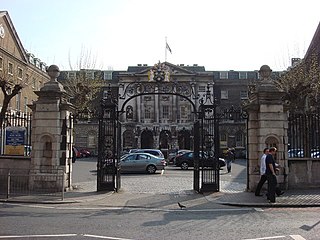
A limited liability partnership (LLP) is a partnership in which some or all partners have limited liabilities. It therefore can exhibit aspects of both partnerships and corporations. In an LLP, each partner is not responsible or liable for another partner's misconduct or negligence. This distinguishes an LLP from a traditional partnership under the UK Partnership Act 1890, in which each partner has joint liability. In an LLP, some or all partners have a form of limited liability similar to that of the shareholders of a corporation. Depending on the jurisdiction, however, the limited liability may extend only to the negligence or misconduct of the other partners, and the partners may be personally liable for other liabilities of the firm or partners.
Respondeat superior is a doctrine that a party is responsible for acts of their agents. For example, in the United States, there are circumstances when an employer is liable for acts of employees performed within the course of their employment. This rule is also called the master-servant rule, recognized in both common law and civil law jurisdictions.
In law, liable means "responsible or answerable in law; legally obligated". Legal liability concerns both civil law and criminal law and can arise from various areas of law, such as contracts, torts, taxes, or fines given by government agencies. The claimant is the one who seeks to establish, or prove, liability.
Vicarious liability is a form of a strict, secondary liability that arises under the common law doctrine of agency, respondeat superior, the responsibility of the superior for the acts of their subordinate or, in a broader sense, the responsibility of any third party that had the "right, ability or duty to control" the activities of a violator. It can be distinguished from contributory liability, another form of secondary liability, which is rooted in the tort theory of enterprise liability because, unlike contributory infringement, knowledge is not an element of vicarious liability. The law has developed the view that some relationships by their nature require the person who engages others to accept responsibility for the wrongdoing of those others. The most important such relationship for practical purposes is that of employer and employee.

English tort law concerns the compensation for harm to people's rights to health and safety, a clean environment, property, their economic interests, or their reputations. A "tort" is a wrong in civil law, rather than criminal law, that usually requires a payment of money to make up for damage that is caused. Alongside contracts and unjust enrichment, tort law is usually seen as forming one of the three main pillars of the law of obligations.

Salomon v A Salomon & Co Ltd[1896] UKHL 1, [1897] AC 22 is a landmark UK company law case. The effect of the House of Lords' unanimous ruling was to uphold firmly the doctrine of corporate personality, as set out in the Companies Act 1862, so that creditors of an insolvent company could not sue the company's shareholders for payment of outstanding debts.
In commercial law, a principal is a person, legal or natural, who authorizes an agent to act to create one or more legal relationships with a third party. This branch of law is called agency and relies on the common law proposition qui facit per alium, facit per se.
A civil conspiracy is a form of conspiracy involving an agreement between two or more parties to deprive a third party of legal rights or deceive a third party to obtain an illegal objective. A form of collusion, a conspiracy may also refer to a group of people who make an agreement to form a partnership in which each member becomes the agent or partner of every other member and engage in planning or agreeing to commit some act. It is not necessary that the conspirators be involved in all stages of planning or be aware of all details. Any voluntary agreement and some overt act by one conspirator in furtherance of the plan are the main elements necessary to prove a conspiracy.

Lipkin Gorman v Karpnale Ltd[1988] UKHL 12 is a foundational English unjust enrichment case. The House of Lords unanimously established that the basis of an action for money had and received is the principle of unjust enrichment, and that an award of restitution is subject to a defence of change of position. This secured unjust enrichment as the third pillar in English law of the law of obligations, along with contract and tort. It has been called a landmark decision.
Vicarious liability in English law is a doctrine of English tort law that imposes strict liability on employers for the wrongdoings of their employees. Generally, an employer will be held liable for any tort committed while an employee is conducting their duties. This liability has expanded in recent years following the decision in Lister v Hesley Hall Ltd to better cover intentional torts, such as sexual assault and deceit. Historically, it was held that most intentional wrongdoings were not in the course of ordinary employment, but recent case law suggests that where an action is closely connected with an employee's duties, an employer can be found vicariously liable. The leading case is now the Supreme Court decision in Catholic Child Welfare Society v Institute of the Brothers of the Christian Schools, which emphasised the concept of "enterprise risk".

Lister v Hesley Hall Ltd [2001] UKHL 22 is an English tort law case, creating a new precedent for finding where an employer is vicariously liable for the torts of their employees. Prior to this decision, it had been found that sexual abuse by employees of others could not be seen as in the course of their employment, precluding recovery from the employer. The majority of the House of Lords however overruled the Court of Appeal, and these earlier decisions, establishing that the "relative closeness" connecting the tort and the nature of an individual's employment established liability.

Mattis v Pollock [2003] 1 WLR 2158 is an English tort law case, establishing an employer's vicarious liability for assault, even where it may be intentional or pre-meditated. Previously, judges had been unwilling to impose liability where assaults were motivated by revenge or vengeance; it was established however that following the decision of Lister v Hesley Hall Ltd, that where an assault is closely linked to the duties of an employee, the employer should be held vicariously liable.

Bazley v Curry, [1999] 2 SCR 534 is a Supreme Court of Canada decision on the topic of vicarious liability where the Court held that a non-profit organization may be held vicariously liable in tort law for sexual misconduct by one of its employees. The decision has widely influenced jurisprudence on vicarious liability outside of Canada.
Dishonest assistance, or knowing assistance, is a type of third party liability under English trust law. It is usually seen as one of two liabilities established in Barnes v Addy, the other one being knowing receipt. To be liable for dishonest assistance, there must be a breach of trust or fiduciary duty by someone other than the defendant, the defendant must have helped that person in the breach, and the defendant must have a dishonest state of mind. The liability itself is well established, but the mental element of dishonesty is subject to considerable controversy which sprang from the House of Lords case Twinsectra Ltd v Yardley.

Twinsectra Ltd v Yardley[2002] UKHL 12 is a leading case in English trusts law. It provides authoritative rulings in the areas of Quistclose trusts and dishonest assistance.

Majrowski v Guy's and St Thomas' NHS Trust [2006] UKHL 34 is a UK labour law case holding that an employer will be vicariously liable for the harassment of an employee by another.

Barnes v Addy (1874) LR 9 Ch App 244 was a decision of the Court of Appeal in Chancery. It established that, in English trusts law, third parties could be liable for a breach of trust in two circumstances, referred to as the two 'limbs' of Barnes v Addy: knowing receipt and knowing assistance.

Viasystems (Tyneside) Ltd v Thermal Transfer (Northern) Ltd[2005] EWCA Civ 1151 is an English tort law and UK labour law case, which held that a worker can have more than one employer at the same time, who will be vicariously liable for the worker.

AIB Group (UK) plc v Mark Redler & Co Solicitors [2014] UKSC 58 is an English trust law case, concerning the applicable principles of causation for a breach of trust. It held that a "but for" test of causation applies for equitable compensation.
Catholic Child Welfare Society v Institute of the Brothers of the Christian Schools [2012] UKSC 56 is an English tort law case, concerning enterprise liability.